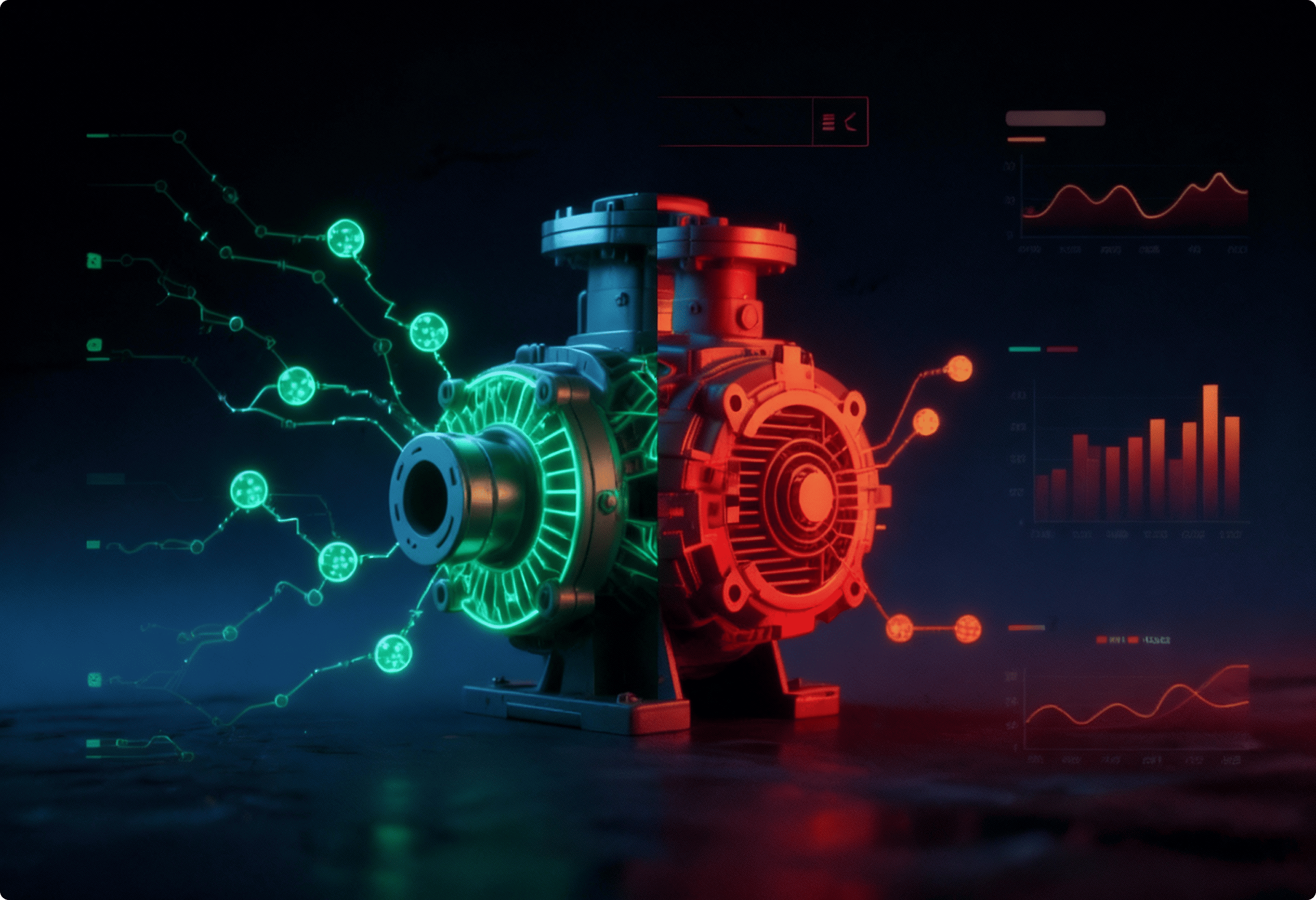Machine Learning for Equipment Failure Detection and Prevention
How to select ML algorithms for industrial failure prediction, achieve 80-95% detection accuracy, and deploy models that prevent costly equipment breakdowns across manufacturing, energy, and transportation sectors.

TL;DR
Machine learning transforms equipment maintenance by detecting failure patterns invisible to traditional monitoring systems. Leading implementations achieve 80-95% failure prediction accuracy with 3-7 day warning windows, reducing unplanned downtime by 40-65% and cutting maintenance costs by 25-40%. However, 58% of ML maintenance projects fail due to insufficient training data, poor feature engineering, or models that can’t integrate with operational workflows.
Highlights
- Start with supervised learning algorithms (Random Forest, XGBoost) for failure classification when you have labeled historical failures
- Use unsupervised methods (Isolation Forest, Autoencoders) for anomaly detection when failure examples are sparse or unknown
- Prioritize feature engineering over algorithm selection — domain-informed features improve accuracy by 20-35% compared to raw sensor data
Introduction
A bearing failure at a Norwegian aluminum smelter destroyed a €4.5 million casting machine and halted production for 11 days. Total cost: €18 million in equipment replacement, lost production, and emergency repairs. The bearing had been monitored — temperature sensors, vibration analysis, regular inspections. Everything showed normal until catastrophic failure occurred in under 90 minutes.
Six months later, they deployed machine learning models analyzing the same sensor streams. The ML system flagged an identical failure pattern 72 hours before another bearing failed. Maintenance replaced it during a scheduled weekend shutdown. Cost: €12,000 for the bearing plus planned labor. The ML model had learned subtle correlations between vibration frequency shifts, temperature fluctuations, and load variations that human analysis and threshold alarms completely missed.
Machine learning detects failures traditional methods can’t see. According to McKinsey’s 2024 industrial AI report, manufacturers deploying ML for failure detection report 40-65% reductions in unplanned downtime and 25-40% lower maintenance costs. Yet implementation success rates remain disappointingly low — Deloitte found that 58% of ML maintenance initiatives launched in 2022 either failed or never reached production deployment.
The technology works. Implementation approach determines success or failure. This guide walks through algorithm selection, feature engineering, model validation, and production deployment based on real implementations across automotive plants, power generation facilities, and rail networks.
Three technical decisions drive outcomes: choosing between supervised and unsupervised learning based on available data, engineering features that capture failure physics, and deploying models that integrate with existing maintenance operations rather than requiring parallel workflows.
Why Traditional Methods Miss Failures
Threshold-based alarms trigger when sensor values cross predefined limits. Vibration exceeds 10mm/s? Alert. Temperature above 85°C? Alert. This approach generates false positives during normal operational variations and misses failures developing below alarm thresholds.
Preventive maintenance schedules replacements based on time or usage cycles regardless of actual condition. A motor rated for 8,000 hours gets serviced at 8,000 hours whether it needs it or not. This wastes money on premature replacements while missing early failures between scheduled intervals.
The core issue: equipment failures emerge from complex interactions between multiple variables over time. A pump doesn’t fail because vibration is high — it fails because vibration increased 15% while temperature rose 8°C and flow rate dropped 12% over three weeks. These multivariate patterns are invisible to single-variable thresholds.
The best machine learning model is the one that gets deployed and used. A simple model in production beats a sophisticated model in a notebook every time.
— Andrew Ng, Founder of DeepLearning.AI
The Data Quality Challenge
ML models need failure examples to learn from. Most facilities have extensive logs of normal operation but minimal failure data. Equipment runs reliably for years before breaking. When it does fail, root cause often goes undocumented or misclassified.
A German automotive plant tried building ML models for press failures. They had 18 months of sensor data but only 7 documented failures — insufficient for training robust models. Failure labels were vague: “hydraulic issue,” “electrical fault,” “operator error.” Without specific failure modes labeled, models couldn’t learn distinct patterns.
Class imbalance kills model performance. Dataset contains 50,000 hours of normal operation and 12 hours of pre-failure conditions. Naive models achieve 99.98% accuracy by predicting “normal” constantly — useless for actual failure detection.
Feature selection without domain knowledge produces spurious correlations. A model trained on raw sensor data learned that failures correlated with Monday mornings. Actual cause: operators restarted equipment after weekend shutdowns, temporarily elevating vibration readings that coincided with unrelated failure events.
Algorithm Selection Framework
Supervised learning works when you have labeled failure examples. Random Forest and XGBoost excel at classification — will this asset fail in the next 7 days? Train on historical failures with sensor features. Expect 80-92% accuracy with 30+ failure examples. Fast to train, interpretable through feature importance scores.
Unsupervised learning handles sparse failure data. Isolation Forest and Autoencoders learn normal operation patterns, flag deviations as anomalies. No failure labels required — just normal operation data. Accuracy: 70-85%. Higher false positives (15-25%) but catches unknown failure modes.
Time-series models (LSTM, GRU) predict remaining useful life when you have sequential degradation data. Analyze sensor trends over time. Require 50+ failure cycles. Best for gradual failures like bearing wear, battery degradation, tool wear.
Feature Engineering Essentials
Raw sensor values rarely predict failures effectively. Transform them into meaningful features:
- Statistical features: Rolling mean, standard deviation, min/max over windows (1 hour, 24 hours, 7 days)
- Frequency domain: FFT peaks, spectral entropy from vibration data
- Rate of change: Temperature delta per hour, vibration acceleration
- Contextual ratios: Temperature/load, current draw/speed, pressure/flow rate
A manufacturing plant went from 8 raw sensors to 42 engineered features. Model accuracy jumped from 68% to 89%. Feature engineering matters more than algorithm choice.
Watch: This video — AI-Driven Predictive Maintenance of Industrial Equipment — provides a comprehensive overview of how machine learning is applied to industrial predictive maintenance, including use cases, signal analysis, deployment workflows, and interpretability.
ML Algorithm Comparison
| Algorithm | Best For | Accuracy | Key Limitation |
| Random Forest | Tabular data, 30+ failures | 82-90% | Needs labeled failures |
| XGBoost | Imbalanced datasets | 85-92% | Prone to overfitting |
| Isolation Forest | Sparse failure data | 70-85% | High false positives (15-25%) |
| Autoencoder | Complex patterns | 78-88% | Black-box, needs GPU |
Implementation Approaches
| Approach | Data Needed | Build Time | Production Cost |
| Supervised | Labeled failures (30+) | 6-10 weeks | Low (CPU sufficient) |
| Unsupervised | Normal operation only | 8-12 weeks | Medium (more tuning) |
| Time-Series | Sequential data, 50+ cycles | 12-16 weeks | High (GPU for LSTM) |
| Hybrid | Mixed data types | 14-20 weeks | High (complex stack) |
Real Implementation Case
Railway Traction Motor Failures

Challenge: UK rail operator faced traction motor failures costing £85K per incident. Traditional monitoring missed 60% of failures.
Approach: XGBoost model on motor current, temperature, vibration data. Engineered 38 features including current harmonics and temperature gradients. Trained on 42 historical failures over 2 years.


Results: 88% accuracy predicting failures 4-7 days ahead. Reduced emergency repairs by 71%. False positive rate: 9%. Investment: £180K. Annual savings: £640K from prevented failures and optimized maintenance scheduling.
Key lesson: Feature engineering drove success — current harmonics revealed bearing wear patterns invisible in raw data.

8-Week ML Deployment
| Week | Phase | Deliverables |
| 1-2 | Data Preparation | Clean dataset, label failures, split train/test |
| 3-4 | Feature Engineering | Create 30-50 features, validate with domain experts |
| 5-6 | Model Training | Train 3 algorithms, tune hyperparameters, select best |
| 7 | Validation | Test on holdout data, measure precision/recall/F1 |
| 8 | Deployment | API integration, monitoring dashboard, alert system |
Critical factors: Use SMOTE or class weights for imbalanced data. Validate with time-based splits, not random — train on months 1-12, test on month 13. Monitor model drift monthly by tracking prediction accuracy on new data.
Pitfalls and Best Practices
Data leakage: Including future information in training data inflates accuracy artificially. A plant achieved 96% accuracy but included “maintenance_scheduled” flag set after inspections detected issues. Model learned to predict scheduling, not failures.
Ignoring domain knowledge: Pure data-driven approaches miss physics. Include features like temperature/load ratio, not just raw temperature. Consult maintenance engineers during feature engineering.
Model drift: Accuracy degrades as equipment ages or conditions change. An industrial compressor model dropped from 87% to 64% over a year as operational patterns shifted. Retrain quarterly or when accuracy falls below 75%.
Best practices: Track feature importance — if top features change suddenly, investigate data quality. Use ensemble methods (combine Random Forest + XGBoost) for robustness. Build prediction confidence scores — only alert when confidence exceeds 70%.
Key Insights
- Feature engineering delivers 80% of model performance. Domain-informed features like temperature gradients, vibration frequency bands, and load-normalized metrics outperform raw sensor values by 20-35%. Invest more time in feature design than algorithm tuning.
- Start with simpler algorithms before deep learning. Random Forest and XGBoost solve 75% of industrial failure detection problems with interpretable results and minimal computational cost. Reserve LSTM for cases where simpler methods fail.
- Production deployment determines business value. Models achieving 90% accuracy in testing but requiring manual interpretation see only 25% adoption. Auto-generate work orders with failure probability, recommended action, and confidence score for 80%+ adoption rates.
Related Resources
How to Choose a Web Development Company in the USA — and Why the Market Is Evolving Faster Than Ever
Discover a web partner who can productionize ML pipelines, secure data flows, and build scalable dashboards and APIs.
CMMS Software Selection Guide: Choosing the Right System in 2026
Struggling to choose a CMMS? This guide breaks down top platforms, selection criteria, and hidden ownership costs.
Remote Asset Management: Technologies for Distributed Operations
Discover how modern telemetry and dashboards enable real-time control of assets across multiple remote sites.
Conclusion
Machine learning detects equipment failures traditional methods miss. The evidence is clear: 80-95% prediction accuracy, 40-65% downtime reduction, 25-40% maintenance cost savings. But only when implemented correctly.
Success comes from three technical choices: matching algorithms to available data, engineering features that capture failure physics, and deploying predictions into existing workflows rather than parallel systems.
The ML landscape in 2026 favors practitioners over theorists. Cloud AutoML platforms reduce development time. Open-source libraries eliminate licensing barriers. Pre-trained models accelerate deployment. Technical barriers have collapsed.
What separates winners from the 58% who fail? Disciplined focus on business problems over algorithmic elegance. Start with expensive failure modes, prove value quickly, scale methodically.
Equipment failures cost too much to leave detection to threshold alarms and fixed schedules. The question isn’t whether to deploy ML — it’s whether you’ll do it before competitors do.